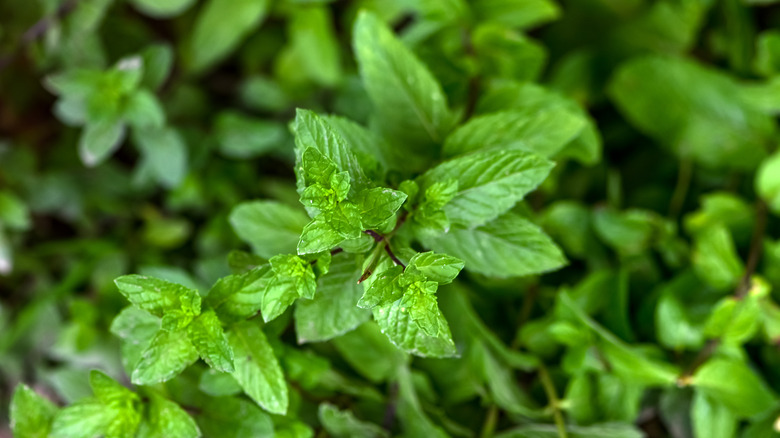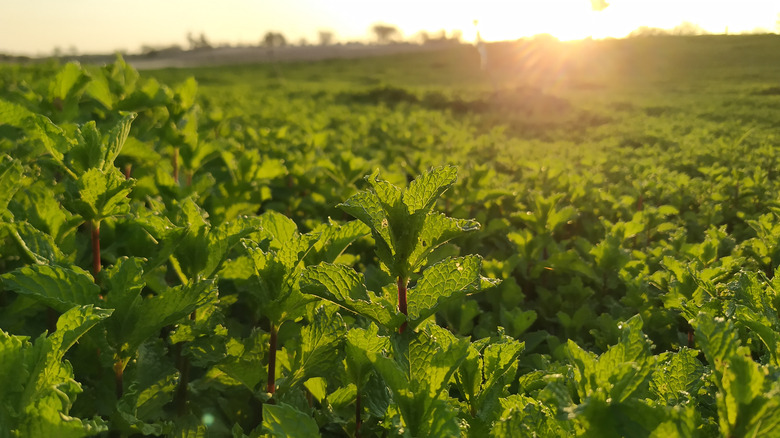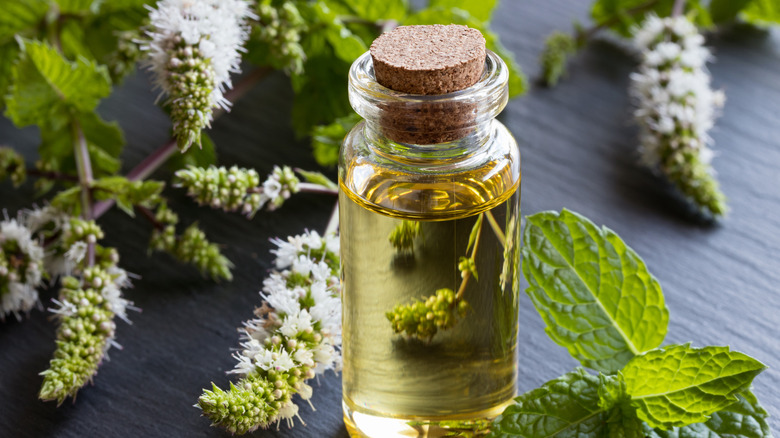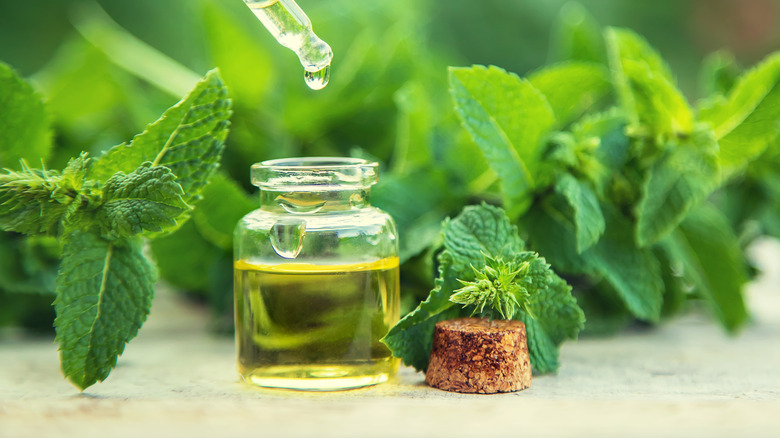Most Of The World's Mint Comes From This Country
Peppermint is to winter, what pumpkin spice is to fall. Whether you're a habitual peppermint tea drinker, seasonal peppermint mocha and candy cane lover, or someone who indulges in peppermint ice cream in the summer heat, you know there is something comforting about that green minty flavor.
Britannica tells us that peppermint (Mentha piperita) is a herb with a sweet smell, warm flavor, and a noteworthy cool aftertaste, which you'll be familiar with if you've ever chewed on a strip of peppermint gum. The archive says that while the leaves are traditionally used fresh, the mint flowers are dried and used to make candy and desserts.
Peppermint is one of over 600 different kinds of mint plants cultivated on the planet today and is fathered from spearmint which we also consume in the form of gum, mint paste, tea, and more (via Quality Logo Products). And, the herb is now used around the globe in a multitude of ways.
Where in the world is all the mint coming from?
Mint is everywhere in the United States. We put it in our toothpaste, water, coffee, gum, candy, and, well ... you get the picture. So, it makes perfect sense that a country so utterly obsessed with mint produces the most of it! Biz Fluent lists the top three mint-producing countries as the United States, India, and China.
Peppermint and spearmint are the most mass-produced mints, taking up at least 25,800 acres of farmland before 2018, according to the University of Nebraska's Institute of Agriculture and Natural Resources. The United States is estimated to produce 70% of the world's total mint production, and 84% of that production comes from the states of Oregon, Washington, and Idaho.
In its first year, mint is traditionally grown in lush green rows. The plant doesn't rely on seeds to repopulate and is one of the most aggressive growers in the world (via Mountain Valley Growers). These fast-spreading herbs thrive in the Pacific Northwest of the U.S. because they prefer a moist climate with well-draining soil and partial shade which are common characteristics of the Northwest's environment.
The History of Mint
Mint is an old herb. So old, in fact, that it can be found in the ancient Egyptian Ebers Papyrus from 1550 B.C. According to JSTOR Digital Library, the Ebers Papyrus is one of the oldest medical texts in the world to date and lists that mint is good at soothing stomach upsets. The ancient use of mint for medical purposes extends to the Greek and Roman eras as well, where physicians would use the herb to mask the smell of decaying corpses. Pliny the Elder even suggested applying mint to the temples for headaches, according to the National Museum of Civil War Medicine. It honestly seems like our mint practices haven't changed all that much, we still use the plant to aid stomach aches and use its menthol smell to ease our heads, although — unlike the Greeks — we no longer believe mint is an effective Plan B.
According to the ancient Greek religion, mint is named after a nymph named Menthe. Hades' wife, Persephone, was convinced that a little nymph named Minthe was having an affair with her husband. In a rage of jealousy, the queen of the underworld turned Minthe into the small green herb. Taking pity on his girlfriend's fate, Hades added a sweet smell to the herb so that Minthe could still bring joy to those who encountered her (via the New York Botanical Garden).
Good for you inside and out
We associate mint with good health and cleanliness because we put it in cleaning solutions and things like toothpaste, deodorant, and mouthwash. When you bite into anything with peppermint whether that be a stick of gum or the actual leaf of the herb, your mouth should start to feel cold and clean and that is all thanks to menthol. Science World describes menthol — or peppermint camphor — as a chemical that doesn't actually cool you but tricks your brain into thinking it does. Menthol can be applied topically to relieve itching, muscle pain, and headaches or peppermint can be ingested to help improve Irritable Bowel Syndrome (via Healthline). It seems like the ancient Greek and Egyptian physicians knew their stuff when it came to the health benefits of mint.
But, that's not all peppermint is good for. These days, grandmothers may force you to drink strong peppermint tea simply or rub peppermint oil under your nose when you have a cold to make you feel better. This may seem like some sort of snake-oil medicine, but in reality, peppermint is absolutely stuffed with antioxidants that aid in the body's general health and well-being (via ScienceDirect). Additionally, though peppermint doesn't truly act as a decongestant, Healthline states that it can give you a feeling of being unclogged.



